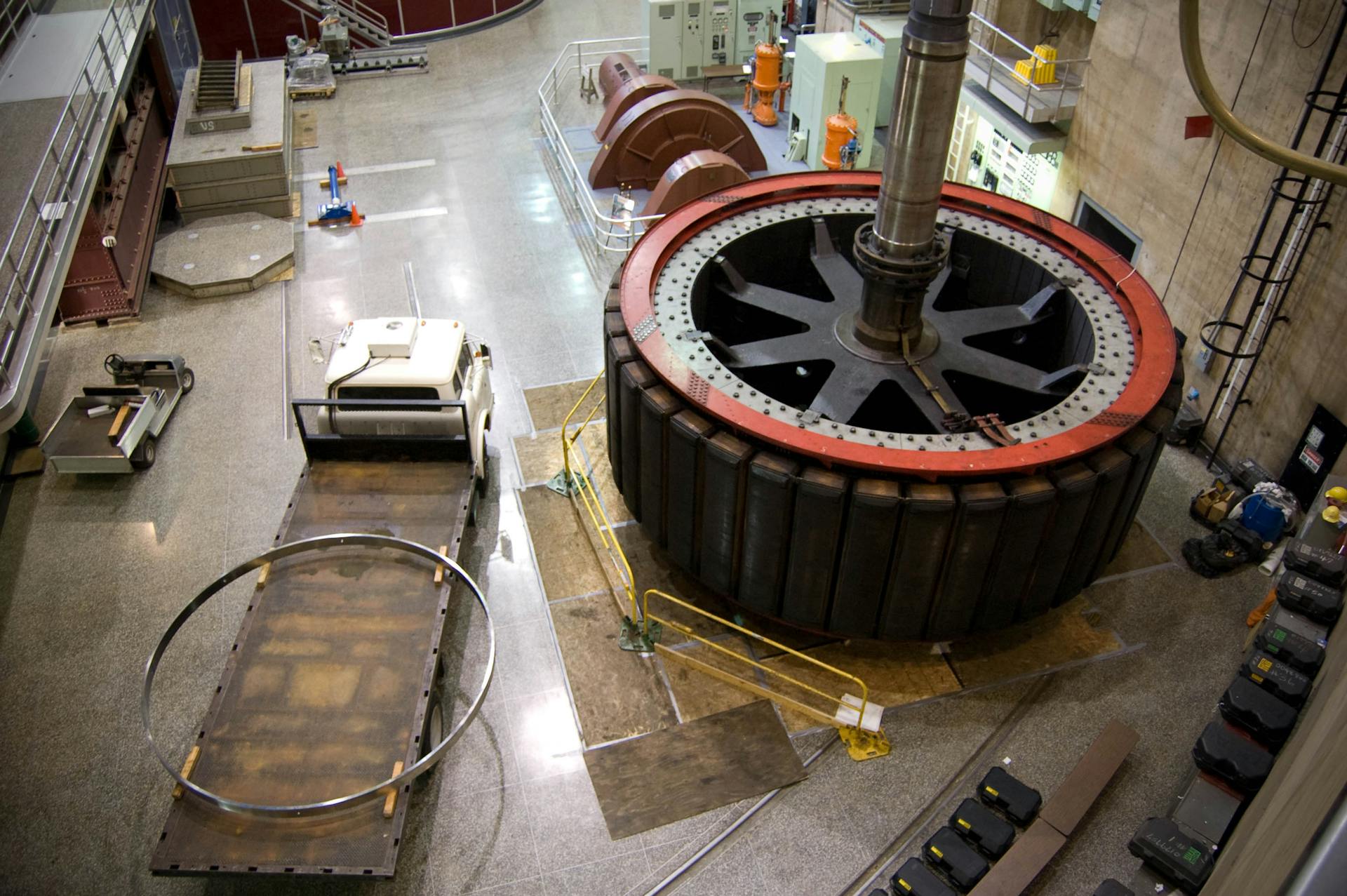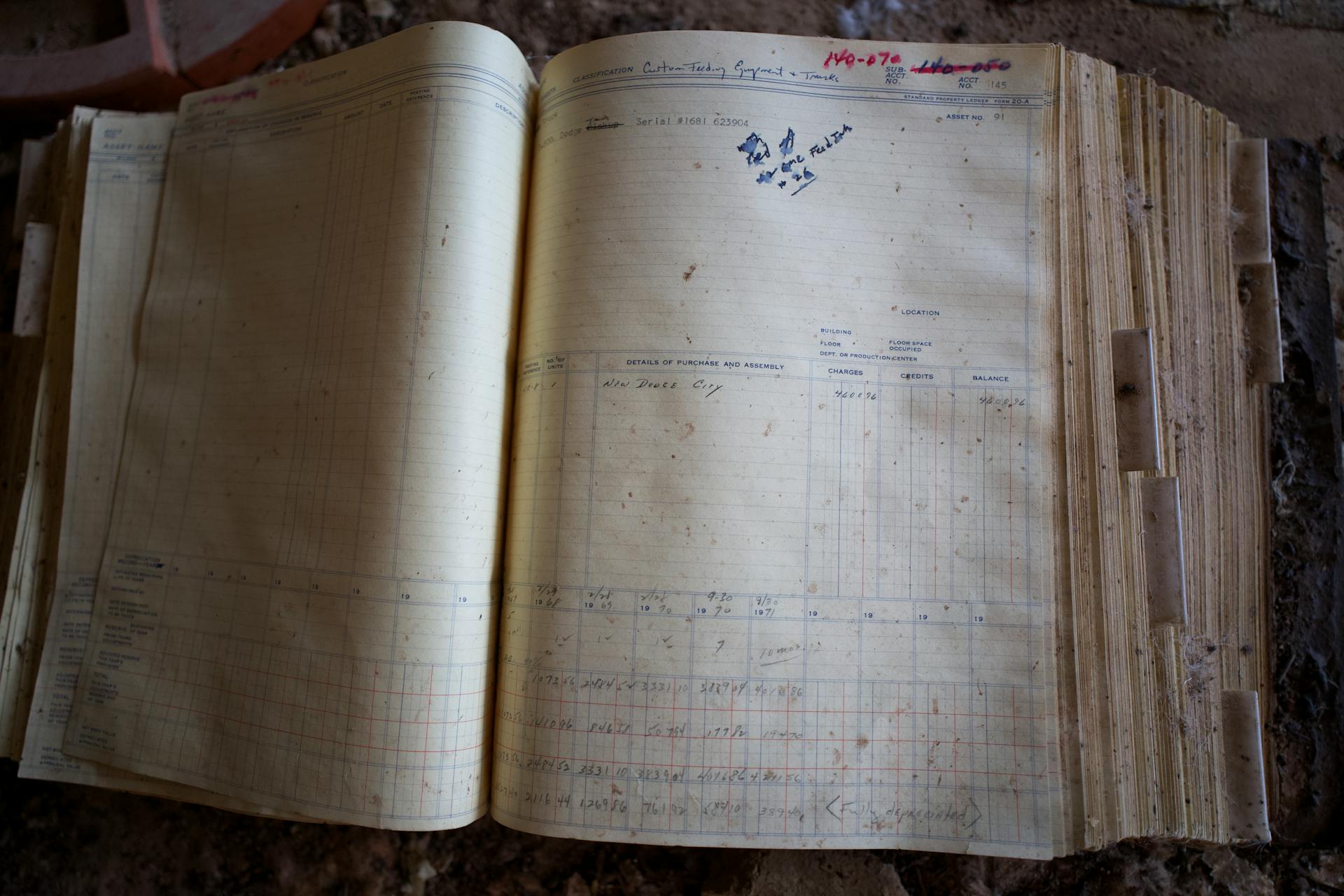
Depreciation is indeed a non-cash expense, which means it doesn't directly affect a company's cash flow.
Depreciation is a method of allocating the cost of a tangible asset over its useful life, and it's a key concept in accounting.
According to the matching principle, depreciation is matched against the revenue generated by the asset, which helps to accurately reflect the true cost of goods sold.
Depreciation is not a direct expense, but rather an allocation of the asset's cost over time, which can be confusing for some.
Depreciation can be calculated using various methods, such as straight-line or accelerated depreciation, depending on the type of asset and its useful life.
Intriguing read: Is Straight Line Depreciation a Fixed Cost
What Are Non-Cash Expenses?
Non-cash expenses are expenses that don't involve the payment or outflow of cash. They still affect a business's net profit, but instead of using cash, they affect other assets.
Businesses that use the accrual accounting method are familiar with non-cash expenses. This method allows them to record expenses as they are incurred, rather than when cash is actually paid.
Non-cash expenses often involve estimates, such as the computation of depreciation. Depreciation estimates include the asset's salvage value and its useful life.
Most non-cash expenses don't have a definite amount, unlike cash expenses.
Here's an interesting read: T Account Debit Credit
Recording Business Expenses

Recording business expenses is an essential part of financial accounting. Non-cash expenses, such as depreciation, don't involve the outflow of cash, but they still decrease a business's net profit.
They typically involve a decrease in the value of a non-cash asset, like a long-term asset that gradually loses its monetary value over time. Depreciation represents this decrease in value.
Non-cash expenses are recorded to reflect their effects in financial statements, preventing the overstatement of assets and net profit. They're added back to net profit to reverse their effects.
The difference between depreciation and amortization is that depreciation applies to tangible long-term assets, while amortization applies to intangible assets like copyrights and patents.
Here's how non-cash expenses affect financial statements:
- Income Statement: Depreciation and amortization expenses are often embedded within the cost of goods sold or operating expenses section.
- Cash Flow Statement: Non-cash expenses are reported on the cash flow statement and treated as a non-cash add-back that increases the cash flow reported in a given period.
- Balance Sheet: Depreciation reduces the carrying value of tangible assets, while amortization reduces the carrying balance of intangible assets.
Non-Cash Expenses
Non-cash expenses are expenses that don't involve the payment or outflow of cash, but still affect a business's net profit.
They typically involve a decrease in the value of a non-cash asset, such as depreciation decreasing the value of a long-term/capital asset.
Check this out: Cash Flow Statement for Non Profit Organisation

Non-cash expenses are recorded to reflect their effects on a business's financial statements, preventing the overstatement of assets and net profit.
Examples of non-cash expenses include spoilage decreasing the value of inventory, bad debt expense decreasing the value of accounts receivable, and depreciation decreasing the value of a building or equipment.
Depreciation is a type of non-cash expense that represents the gradual decrease in an asset's value over time, due to usage or passage of time.
Non-cash expenses are often estimated, as in the case of depreciation, which involves estimates of an asset's salvage value and useful life.
The accounting for non-cash expenses is summarized as follows: a debit to the expense account and a credit to the corresponding asset account.
Here are some examples of non-cash expenses:
- Depreciation expense
- Amortization expense
- Spoilage
- Bad debt expense
Non-cash expenses are recorded on the income statement and balance sheet, and may also appear on the cash flow statement if the indirect method is used.
The impact of non-cash expenses on financial statements is significant, as they affect a business's net profit and asset values.
By recording non-cash expenses, businesses can accurately reflect their financial performance and position.
Explore further: Depreciation Expense Formula for Non Profit Organization
Expense

Depreciation is indeed a non-cash expense, which means it doesn't involve the outflow of cash, but still decreases the business's net profit.
Non-cash expenses like depreciation decrease the value of a non-cash asset, such as a long-term asset like a building.
These expenses are typically recorded on the balance sheet and income statement, but may also appear on the cash flow statement if the indirect method is used.
Depreciation represents the gradual decrease in an asset's value over time, usually due to usage or the passage of time.
A tangible long-term asset like a building will have to be recorded for depreciation as long as it has value left.
If the asset's remaining value equals its estimated salvage value, then depreciation recording for that asset ends.
Examples of non-cash expenses include spoilage decreasing the value of inventory, and bad debt expense decreasing the value of accounts receivable.
Non-cash expenses like depreciation and amortization are recorded at the top of the cash flow statement as an add-back to accrual-based net income.
For your interest: Does Bank of America Cash Checks for Non Customers

Here's a breakdown of how depreciation and amortization impact the financial statements:
- Income Statement: Depreciation and amortization expense is often embedded within the cost of goods sold (COGS) or operating expenses section.
- Cash Flow Statement: Depreciation and amortization are reported on the cash flow statement and treated as a non-cash add-back that increases the cash flow reported in a given period.
- Balance Sheet: Depreciation reduces the carrying value of the coinciding tangible asset, while amortization reduces the carrying balance of the corresponding intangible assets.
Asset Write-Downs
Asset write-downs occur when an asset's market value drops below its book value, prompting the business to reduce the book value to match the market value.
This decrease in book value results in a loss, which is represented by an asset write-down, a non-cash expense.
An asset write-down is essentially a loss that doesn't involve any actual cash outflow, but rather a revaluation of the asset's worth.
It's worth noting that an asset write-down can happen to any asset, not just tangible ones like equipment or property.
The decrease in book value due to an asset write-down is a non-cash expense, which means it doesn't involve any actual cash outflow.
Asset write-downs can have significant implications for a business's financial statements and can be a complex process to navigate.
A unique perspective: Depreciation Is an Expense or Loss
Non Cash Expenses
Non cash expenses are a crucial part of a business's financial statements, and they're often misunderstood. They don't involve the outflow of cash, but they still decrease a business's net profit.

Non cash expenses typically involve a decrease in the value of a non cash asset, such as a long-term asset or an intangible asset. For example, depreciation decreases the value of a tangible long-term asset, while amortization expense decreases the value of an intangible asset.
Examples of non cash expenses include spoilage, which decreases the value of inventory, and bad debt expense, which decreases the value of accounts receivable. Other examples include depreciation, amortization expense, and impairment losses.
Non cash expenses are added back to the net profit of a business to reverse their effects. This is because they don't involve the outflow of cash, but they still affect a business's financial statements.
Here are some examples of non cash expenses:
- Depreciation: a decrease in the value of a tangible long-term asset
- Amortization expense: a decrease in the value of an intangible asset
- Bad debt expense: a decrease in the value of accounts receivable
- Spoilage: a decrease in the value of inventory
Non cash expenses can be found on a business's balance sheet and income statement, but they may also appear on the cash flow statement if the business is using the indirect method. They are typically consolidated for reporting purposes and are often reported as a non cash add-back on the cash flow statement.
Headings
Depreciation is a non-cash expense. It's an estimate of the reduction in value of a long-term asset over its useful life. This reduction is recorded as an expense in the income statement each accounting period.
The depreciation expense is calculated by dividing the asset's cost by its useful life. For example, if a business purchases an asset costing 10,000 with a useful life of 5 years, the depreciation expense would be 2,000 per year.
The depreciation journal entry is simply an accounting entry that doesn't involve the movement of cash. It's made up of two accounts: Depreciation expense and Accumulated depreciation.
Here's a breakdown of the journal entry:
Note that this entry is not a cash transaction, but rather an accounting adjustment to reflect the asset's decreasing value.
Deferred Income Taxes
Deferred income taxes can be a bit tricky to understand, but essentially, it's about the difference in how businesses and tax authorities treat income, expenses, assets, and liabilities. This difference can lead to a deferred tax expense, which is a non-cash expense.
Here's an interesting read: For a Firm That Must Pay Income Taxes Depreciation Expense

A deferred tax expense of 1,000, for example, can result from the different treatment of depreciation by the business and the tax authorities. The bookkeeping journal to record this is a simple accounting entry.
The entry involves debiting income tax expense and crediting deferred tax liability, with no movement of cash involved. However, the net income of the business has been reduced by the increased income tax expense of 1,000.
To correct the position for the cash flow statement, the income tax expense resulting from the deferred tax liability needs to be added back to the net income as it is a non-cash expense.
In practice, most companies assume a salvage value of zero for depreciation, which reduces the pre-tax income and income taxes owed. Recognizing a higher depreciation expense reduces the income tax liability recorded on the income statement.
Here are the effects of different depreciation expenses on pre-tax income and tax savings:
- Higher D&A Expense ➝ Lower Pre-Tax Income (EBT) and Greater Tax Savings
- Lower D&A Expense ➝ Higher Pre-Tax Income (EBT) and Lower Tax Savings
The actual taxes paid by a company can be different from the tax expense recorded on the income statement.
Frequently Asked Questions
Is amortization a cash expense?
No, amortization is not a cash expense, as it represents a non-cash reduction in asset value. However, it still affects a company's financial statements and overall financial health.
Sources
- https://fundsnetservices.com/non-cash-expense
- https://www.double-entry-bookkeeping.com/cash-flow-basics/non-cash-expenses/
- https://tax.thomsonreuters.com/blog/amortization-vs-depreciation-what-are-the-differences/
- https://www.wallstreetprep.com/knowledge/depreciation-vs-amortization/
- https://www.deskera.com/blog/is-depreciation-an-operating-expense/
Featured Images: pexels.com


